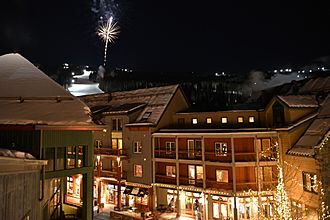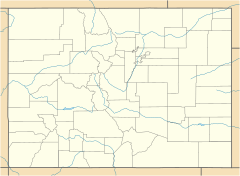Keystone Resort facts for kids
Quick facts for kids Keystone Resort |
|
|---|---|
 |
|
| Location | White River National Forest Summit County, Colorado, United States |
| Nearest city | Keystone, Colorado |
| Coordinates | 39°36′18″N 105°57′15″W / 39.60500°N 105.95417°W |
| Vertical | 3,128 ft (953 m) |
| Top elevation | 12,408 feet (3,782 m) |
| Base elevation | 9,280 feet (2,830 m) |
| Skiable area | 3148 acres (12.7km²) |
| Runs | 135 total (19% beginner 32% intermediate 49% advanced) |
| Longest run | Schoolmarm - 3.5 miles (5.6 km) |
| Lift system | 20 total (2 gondolas, 11 chair lifts (two high speed six packs, four high speed quads, one fixed grip quad, one triple chairlift, three double chairlifts), seven surface lifts) |
| Snowfall | 230 in/year (5.8 m/year) |
| Snowmaking | 662+ acres |
| Night skiing | 15 trails |
Keystone Resort is a popular ski resort found in Keystone, Colorado, USA. Since 1997, a company called Vail Resorts has owned and run it.
Keystone has three main mountains: Dercum Mountain, North Peak, and the Outback. It also has five special areas called Bowls. These are Independence, Erickson, Bergman, North, and South Bowls. You can find ski trails for all skill levels here. Lifts and gondolas connect the three mountains. Keystone also offers night skiing on Dercum Mountain during certain times of the year.
Beyond skiing, Keystone is famous for its large outdoor ice skating lake. You can also enjoy fun sleigh rides. There are many places to stay, like condos, close to the ski areas. In summer, you can ride the lifts for hiking and mountain biking.
Contents
The Story of Keystone Resort
How It All Began
In the 1940s, a man named Max Dercum left his job as a professor. He and his wife, Edna, moved to a ranch near Keystone, Colorado. They were known for loving fun activities. They enjoyed sledding and Max even worked as a rodeo clown.
But most of all, they loved to ski. They skied at many places, including Loveland and Steamboat. Max dreamed of building his own ski area. He even made a model of the mountains to plan it out.
Founding the Resort
Max and Edna lived at their Ski Tip Ranch. From there, they could see Keystone Mountain. Max knew it would be a perfect spot for a ski resort. He spent years exploring the mountain.
In 1969, Max met Bill Bergman. Bill loved Max's idea for Keystone. They shook hands and decided to create Keystone International. Their goal was to build a resort that would be open all year.
They worked hard in 1969 and 1970. They wanted to protect the mountain's natural beauty. Lumbermen carefully cut the ski trails by hand. Max made sure the trails followed the mountain's natural shape. They used helicopters to install lift towers. This helped avoid building too many new roads.
The Keystone Lodge was built to blend in with the area. It faces the mountain and goes down to the Snake River. They also made sure to protect the wetlands nearby. Keystone Resort officially opened on November 21, 1970. A lift ticket cost only $5 that first season!
Olympic Dreams
Keystone almost hosted the 1976 Winter Olympics. Independence Mountain was considered for the downhill skiing event. However, Denver, Colorado, ended up not hosting the games. Before Keystone expanded, people used snowcats and helicopters to ski on Independence Mountain.
Growing the Resort
North Peak Opens
In 1984, North Peak opened for skiing. This added more trails to Keystone. Two trails, Diamond Back and Mozart, connected North Peak to Keystone Mountain. New lifts were also added to help skiers get around. A new base area called River Run also opened. It had a gondola that went all the way to the Summit House.
New Lifts in the 1990s
In 1990, Keystone got faster lifts. Two new high-speed quad chairlifts were built. The Peru Express and Montezuma Express made it quicker to reach different parts of the mountain.
In 1991, Keystone expanded into a new area called the Outback. Three new lifts were built for this expansion. The Outpost Gondola connected Keystone Mountain to a new restaurant. The Outback Express was a fast quad lift for the Outback trails. The Wayback lift helped skiers get to and from the Outback.
In 1997, the Erickson lift was replaced with a new, faster quad lift called the Summit Express. A new triple chairlift, Ranger, was also built for a learning area. In 1998, the Santiago Express replaced an older lift on North Peak.
Improvements in the 2000s
In 2000, the Ruby lift was replaced with a faster six-person lift called the Ruby Express. This made it easier to get out of North Peak and the Outback.
In 2008, the River Run Gondola was replaced with a brand new one. The new gondola's starting point was moved. This made it easier for guests to walk to it. It also has a stop partway up the mountain. This helps skiers avoid the lower part of the access trail.
In 2014, the Outback Express lift was improved to carry more people. For the 2017 season, Keystone built its second high-speed six-person lift. This new lift replaced the Montezuma Express.
Keystone Resort Facts
Mountain Details
- Base Elevation: 9,280 feet (2,830 m)
- Summit Elevation: 12,408 feet (3,782 m)
- Vertical Rise: 3,128 feet (953 m)
Skiing and Snow
- Skiable Area: 3,148 acres (12.74 km2)
- Total Trails: 135
- 19% are for beginners
- 32% are for intermediate skiers
- 49% are for advanced skiers
- Bowls: Independence, Bergman, Erickson, North, and South
- Longest Run: Schoolmarm - 3.5 miles (5.6 km)
- Average Snowfall Each Year: 230 inches (580 cm)
- Terrain Parks:
- The A51 Terrain Park is a special area for tricks.
- It has 51 rails and funboxes.
Mountain Slopes
- North-facing slopes: 47%
- East-facing slopes: 13%
- West-facing slopes: 30%
- South-facing slopes: 10%
Lifts
- Total Lifts: 21
- 2 gondolas: River Run and Outpost
- 2 high-speed six-person chair lifts: Montezuma Express, Ruby Express
- 4 high-speed quad chair lifts: Summit Express, Peru Express, Santiago Express, Outback Express
- 1 quad chair lift: Wayback
- 1 triple chair lift: Ranger
- 3 double chair lifts: A-51, Argentine, and Discovery
- 8 surface lifts (like magic carpets) for beginners and tubing
A51 Terrain Park
Keystone Resort is home to the "A51 Terrain Park" on Dercum Mountain. This park is known as one of the best in the area for skiers and snowboarders to practice tricks.
Summer Fun at Keystone
In the summer, Keystone Resort offers many activities. Visitors can go hiking, horseback riding, and fly-fishing. You can also try whitewater rafting, paddle boating, and stand-up paddleboarding. Mountain biking is very popular too.
Keystone Resort also has two amazing 18-hole golf courses. The Ranch course was designed by a famous golf course architect, Robert Trent Jones Jr.. It is located next to an old ranch.
Working with the Forest Service
Keystone ski area operates on land owned by the U.S. Forest Service. This means they have a special permit to use the land. For this privilege, the ski area pays a fee each year. Part of these fees goes back to Summit County, Colorado, to help with roads and schools. The Forest Service also approves all plans for the resort. This ensures the resort develops in a way that protects the environment.



